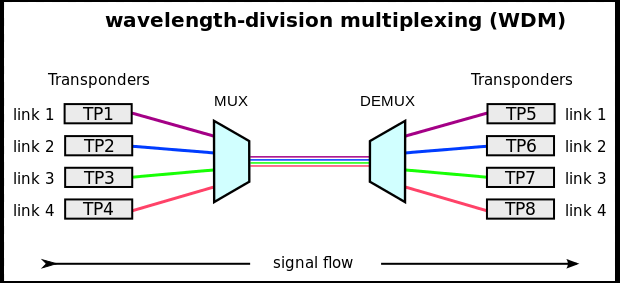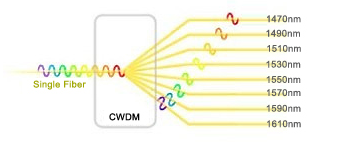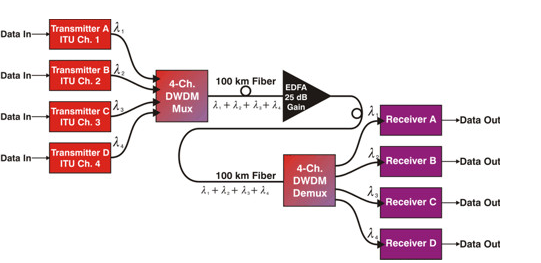Introduction
In fiber-optic communications, wavelength-division multiplexing (WDM) is a technology which multiplexes a number of optical carrier signals into a single optical fiber by using different wavelengths of laser light. This technique enables bidirectional communications over one strand of fiber, as well as multiplication of capacity. A WDM system (Figure 1) uses a multiplexer at the transmitter to join the signals together, and a demultiplexer at the receiver to split them apart. With the right type of fiber it is possible to have a device that does both simultaneously, and can function as an optical add-drop multiplexer. The concept was first published in 1978, and by 1980 WDM systems were being realized in the laboratory. As a system concept, the ways of WDM includes coarse wavelength-division multiplexing (CWDM) and dense wavelength-division multiplexing (DWDM).
Figure 1: The WDM system
The CWDM System
In simple terms, CWDM equipment performs two functions: segregating the light to ensure only the desired combination of wavelengths are used, multiplexing and demultiplexing the signal across a single fiber link.
Typically CWDM solutions provide 8 wavelengths capability, separated by 20nm, from 1470nm to 1610nm, enabling the transport of 8 client interfaces over the same fiber, as is shown in Figure 2. What’s more, CWDM has the capability to transport up to 16 channels (wavelengths) in the spectrum grid from 1270nm to 1610nm with a 20nm channel spacing. Each channel can operate at either 2.5, 4 or 10Gbit/s. CWDM can not be amplified as most of the channels are outside the operating window of the erbium doped fiber amplifier (EDFA) used in Dense Wavelength Division Multiplexing (DWDM) systems. This results in a shorter overall system reach of approximately 100 kilometers. However, due to the broader channel spacing in CWDM, cheaper un-cooled lasers are used, giving a cost advantage over DWDM systems.
Figure 2:The CWDM system
CWDM proves to be the initial entry point for many organizations due to its lower cost. Each CWDM wavelength typically supports up to 2.5Gbps and can be expanded to 10Gbps support. This transfer rate is sufficient to support GbE, Fast Ethernet or 1/2/4/8/10GFC, STM-1/STM-4/STM-16/OC3/OC12/OC48, as well as other protocols.
CWDM is the technology of choice for cost efficiently transporting large amounts of data traffic in telecoms or enterprise networks. Optical networking and especially the use of CWDM technology has proven to be the most cost efficient way of addressing this requirement.
In CWDM applications, a fiber pair (separate transmit and receive) is typically used to serve multiple users by assigning a specific wavelength to each subscriber. The process begins at the head end (HE) or hub, or central office (CO), where individual signals at discrete wavelengths are multiplexed, or combined, onto one fiber for downstream transmission. The multiplexing function is accomplished by means of a passive CWDM multiplexer (Mux) module employing a sequence of wavelength-specific filters. The filters are connected in series to combine the various specific wavelengths onto a single fiber for transmission to the field. In the outside plant a CWDM demultiplexer (Demux) module, essentially a mirror of the Mux, is employed to pull off each specific wavelength from the feeder fiber for distribution to individual FTTX applications.
CWDM is suitable for use in metropolitan applications, also being used in cable television networks, where different wavelengths are used for the downstream and upstream signals. In these systems, the wavelengths used are often widely separated, for example, the downstream signal might be at 1310 nm while the upstream signal is at 1550nm. CWDM can also be used in conjunction with a fiber switch and network interface device to combine multiple fiber lines from the switch over one fiber. CWDM is optimized for a cost conscience budgets in mind, with low-cost, small-powered laser transmitters enabling deployments to closely match guaranteed revenue streams.
The DWDM System
DWDM stands for Dense Wavelength Division Multiplexing. Here “dense” means the wavelength channels are very narrow and close to each other. DWDM uses the same transmission window but with denser channel spacing. Channel plans vary, but a typical system would use 40 channels at 100 GHz spacing or 80 channels with 50 GHz spacing.
DWDM works by combining and transmitting multiple signals simultaneously at different wavelengths on the same fiber, as is shown in Figure 3. In effect, one fiber is transformed into multiple virtual fibers. So, if you were to multiplex eight OC -48 signals into one fiber, you would increase the carrying capacity of that fiber from 2.5 Gb/s to 20 Gb/s. Currently, because of DWDM, single fibers have been able to transmit data at speeds up to 400Gb/s.
Figure 3: The DWDM system
A basic DWDM system contains five main components: a DWDM terminal multiplexer, an intermediate line repeater, an optical add-drop multiplexer (OADM), a DWDM terminal demultiplexer and an Optical Supervisory Channel (OSC). A DWDM terminal multiplexer contains a wavelength-converting transponder for each data signal, an optical multiplexer and an optical amplifier (EDFA). An intermediate line repeater is placed approximately every 80–100 km to compensate for the loss of optical power as the signal travels along the fiber. An optical add-drop multiplexer is a remote amplification site that amplifies the multi-wavelength signal that may have traversed up to 140 km or more before reaching the remote site. A DWDM terminal demultiplexer consisting of an optical demultiplexer and one or more wavelength-converting transponders separates the multi-wavelength optical signal back into individual data signals and outputs them on separate fibers for client-layer systems (such as SONET/SDH). An Optical Supervisory Channel (OSC) is a data channel which uses an additional wavelength usually outside the EDFA amplification band (at 1,510nm, 1,620nm, 1,310nm or another proprietary wavelength).
DWDM is designed for long-haul transmission where wavelengths are packed tightly together and do not suffer the effects of dispersion and attenuation. When boosted by erbium doped fiber amplifiers (EDFAs)—a sort of performance enhancer for high-speed communications—these systems can work over thousands of kilometers. DWDM is widely used for the 1550nm band so as to leverage the capabilities of EDFA. EDFAs are commonly used for the 1525nm ~ 1565nm (C band) and 1570nm ~ 1610nm (L Band).
A key advantage to DWDM is that it’s protocol and bit rate independence. DWDM-based networks can transmit data in IP, ATM, SONET/SDH, and Ethernet, and handle bit rates between 100Mb/s and 2.5Gb/s. Therefore, DWDM-based networks can carry different types of traffic at different speeds over an optical channel. From a QOS standpoint, DWDM-based networks create a lower cost way to quickly respond to customers’ bandwidth demands and protocol changes.
Conclusion
WDM, as a multiplexing technology in optical field, can form a optic-layer network called “all-optic network”, which will be the most advanced level of optical communications. It will be the future trend of optical communications to build a optical network layer based on WDM and OXC to eliminate the bottleneck of photoelectric conversion with a pure all-optic network. As the first and most important step of all-optic network communications, the application and practice of WDM is very advantageous to developing the all-optic network and pushing forward optical communications!



